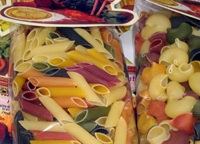There are so many types and names of pasta out there, it’s easy to get confused…
… and particularly troublesome are the variations of pasta that have virtually the same names!

For example, spaghetti and spaghettini… what the heck is that all about?
It’s a good question! And while I won’t be teaching you Italian to explain it all (I know I’d quickly fail), it is useful to understand how and why some pasta variations end up with the names they do. That understanding is the aim of this page.
It’s all in the name!
To explain as clearly as possible, different types of pasta have different names – right? Spaghetti for one, ravioli, penne and so on.
However if you read my A-Z list you’ll also see that some pasta types are actually split into two or even three different sub-types, all with very similar names. Confused? I was at first…
So what is the difference – between spaghetti and spaghettoni say, or penne and pennette? Don’t worry… the differences are very learnable. The trick is just to understand the word endings.
It comes to us all, in the end…
As with other Latin-derived European languages – such as Spanish – Italians just love their word endings. And there are 3 key endings used to differentiate between different versions of pasta. Here’s the lesson part then (xxxx refers to the type of pasta)…
Quick Pasta Naming Guide
xxxx + ini – refers to the smaller version of a pasta
Example: spaghettini is thinner than normal spaghetti, and ditalini are shorter tubed versions of ditali (pasta ‘thimbles’).
xxxx + ette – again refers to the smaller version of a pasta
Because some names of pasta end with e instead of i, ‘ette’ is used instead of ‘ini’ to make the word refer to a smaller object. So just think of ‘ette’ as meaning the same as ‘ini’.

Example: pennette refers to small penne pasta shapes.
xxxx + oni – refers to the larger version of a pasta
Example: fusilli (male plural) refers to pasta shapes that resemble spirals. Therefore fusilloni refers to supersized spirals (see right and this tuna recipe).
It’s actually really easy isn’t it?
If you can remember these differences between the names of pasta, you should avoid any restaurant confusion regarding the particular type of pasta you’re ordering, and you can also impress dinner guests as you serve up a wide range of authentic, knowledgeable pasta variations!
Learning Italian: quick recommendation
If you do want to learn Italian, I very much recommend the Michel Thomas 8-CD audio course.
I’ve used this a lot – indeed I continue to re-listen to it pretty regularly – and I’ve found it easier and quicker to learn from this than any other language books (and I’ve tried a few!), and honestly even more manageable than person-to-person evening classes in school.
All you do is grab a coffee, press Play, and then speak when Michel asks you to. It’s excellent.
Buona fortuna – good luck!